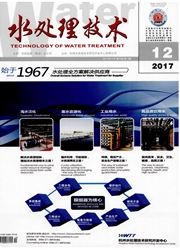

 中文摘要:
中文摘要:
目前,大部分腈纶废水经生化处理后的出水均不能达到排放标准,且出水含难降解物质,深度处理困难。本研究采用O3/UV工艺处理腈纶废水生化出水,考察了臭氧投加量、紫外光强度、反应时间、初始pH对处理效果的影响。结果表明,在不调节原水pH、紫外光强度为85μW/cm2、臭氧投加量为48 mg/L、反应时间为120 min的条件下,COD去除率可达82.1%,出水COD小于60 mg/L,可满足企业因达标排放和总量控制对出水COD的要求,且BOD5/COD可由0.18增加至0.47。因此,O3/UV工艺可有效降低受纳水体的污染负荷,提高腈纶废水出水的可生化性,利于受纳水体的自净作用,提高水环境质量。
 英文摘要:
英文摘要:
Most of the acrylic fiber wastewater after biochemical treatment cannot satisfy the discharge standard currently.Moreover,the effluent contains substances that are hardly biodegradable,making the advanced treatment process more difficult.In this study,The O3/UV process was used to treat biochemical treatment effluent of acrylic fiber wastewater,and the effect of O3 dosage,ultraviolet intensity,reaction time,and initial pH on treatment efficiencywas investigated.The experimental results showed that under the conditions of O3dosage of 48 mg/L,ultraviolet intensity 85μW/cm2,reaction time of 120 min,and initial pH without adjustment,the COD removal rate could reach 82.1%,and the effluent COD was lower than 60 mg/L,which could satisfy the request of discharge standard and total amount of COD.The BOD5/COD ratio increased from 0.18 to 0.47.Therefore,O3/UV process could effectively reduce the pollution load of the receiving water body,and improve the biodegradability of acrylic fiber wastewater effluent,which is beneficial to self-purification action of the receiving water bodyand improve the water qualityof the environment.
 同期刊论文项目
同期刊论文项目
 同项目期刊论文
同项目期刊论文
 期刊信息
期刊信息
